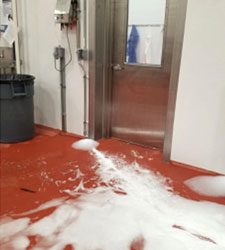April 2019 – Cut Your Chemicals & Your Costs
Inside the Newsletter:
Cut Chemicals & Cost | Food Processing Savings | Avoiding TCE | Food Processing Grant Project | Savings for TRUs | Blast From the Past
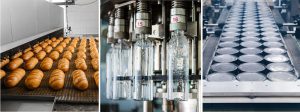 Cut Your Chemicals & Your Costs
Cut Your Chemicals & Your Costs
Food processing is a vital part of the Minnesota economy, providing jobs to 46,000 people throughout the state. Excellent food products are supplied by the industry, but processing these products comes with challenges; the industry emits over 4.5 million pounds of TRI chemicals each year. Read about the project results and a case study to reduce chemical use and costs you can implement at your facility.
There has been a lot of news about trichloroethylene (TCE) in the news and in the legislature this year. If this has you thinking about switching your TCE use to something else, don’t make the wrong switch! Learn how you can receive a no cost evaluation to identify safer options for your process.
Find options to identify Cold Hard Savings for transport refrigeration units while reducing air emissions from your refrigerated transport fleet. And is a Blast from the Past, MnTAP revisits cost saving you can capture by optimizing your compressed air system with MnTAP case studies, tools and assessments.

Savings Under Your Feet – Sanitizing Chemical Reduction at Food Processing Manufacturers
This project was aimed at water, energy and GHG emissions reductions for the Lamb Weston facility in Park Rapids. The intern helped evaluate the potato blanching process for potential improvements in the efficiency of water, chemical and energy usage to align with the facilites sustainability goals.
The MnTAP intern made a simple and cost-effective procedural change to increase the plant’s chemical usage efficiency. The intern focused on optimizing the rate and duration of the application spray time of sanitizing chemical used in foot baths located at 10 entryways to the production floor. This reduced the amount of chemicals being purchased and used, as well as the time spent mixing and delivering the materials to the stations. The modifications resulted in a reduction of 5,000 lbs of chemical, 3,200 gallons of water, and $11,000 in savings every year.
At a separate food manufacturer, it was discovered that by changing the type of floor mats used throughout the facility, the amount of sanitizing chemical used to fill the mats could be reduced by up to 40%. The surface of the mats consisted of densely packed cylindrical nubs designed to dislodge and scrape away soils from footwear. However, because the facility was filling these mats with a powder chemical rather than liquid, a significant amount was lost in the void spaces between the nubs and could not make effective contact with employees’ footwear. It is estimated that switching to mats with flat treads would allow the company to use 600 lbs less sanitizing powder yearly – a savings value of $3,800.
Don’t Make the Wrong Switch: Identifying and Implementing Alternatives to TCE Solvent in Industrial Processes
There are many reasons to avoid using trichloroethylene (TCE), and with recent headlines in Minnesota it is more important than ever! TCE is a hazardous air pollutant (HAP), a Toxic Release Inventory reportable chemical, and legislative restrictions are being considered at the Federal and Minnesota levels. TCE is a known human carcinogen and can contaminate soil, air, and water. Unfortunately, there is no one good option when it comes to replacing TCE in cleaning and other industrial operations so businesses are often left with questions.
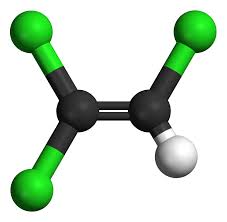
- Should we consider an alternative to TCE in our process?
- Are the alternatives to TCE we are considering really the best options?
- How do we know these alternatives are really better?
If these questions are being asked in your business, you can get no cost assistance for an alternatives assessment and avoid a regrettable substitution. A regrettable substitution is where TCE is replaced with another chemical that is less studied and less regulated, but not necessarily any less hazardous. A regrettable substitution can lead to continued health and environmental risks and the possibility of needing to make another change in the future adding unnecessary risk and cost to your business.
Don’t make the wrong switch! The Minnesota Technical Assistance Program (MnTAP) at the University of Minnesota and the Toxic Use Reduction Institute (TURI) at the University of Massachusetts, Lowell are partnering to provide Minnesota businesses no cost technical assistance to find effective, safer cleaning options
What you will get:
- Training to help identify effective products to replace TCE in your process
- Site assessments to understand your current process and cleaning needs
- Solubility testing to identify safer alternatives to TCE to meet your process needs
- Technical assistance for qualification and implementation of alternatives
There is no cost to your company to participate in this TCE alternatives project. For more information visit the project website or contact Jane Paulson (612-624-1826 or janep2@umn.edu) now and get the information you need to make the right choice to replace TCE in your process. Training is scheduled for June 11, 2019.
Training RegistrationProject InformationThe TCE Alternatives Project is supported with funding from MPCA and U.S. EPA.
Food Processing: MnTAP Completes Two-Year Grant Project
The food processing industry is a vital part of the Minnesota economy, providing jobs to 46,000 people throughout the state. The industry is responsible for providing high quality food products that are delivered safely to customers across the state, nation, and globe. Processing these products comes with its challenges in terms of water, energy, and chemical usage efficiency. MnTAP recently completed a two-year project supported by the MPCA and EPA Region 5 to provide technical assistance to the food processing industry and help facilities with process efficiency and resource usage improvements. The work consisted of initial scoping and outreach to potential facilities and businesses, site visits and system audits, intern projects, follow up guidance, and informational presentations. There were three key focus areas of the project: optimization of onsite cleaning chemical usage; water conservation; and energy efficiency and ammonia leak prevention for large-scale refrigeration systems. This work led to some significant savings opportunities and implemented recommendations to strengthen businesses within this sector of the Minnesota economy.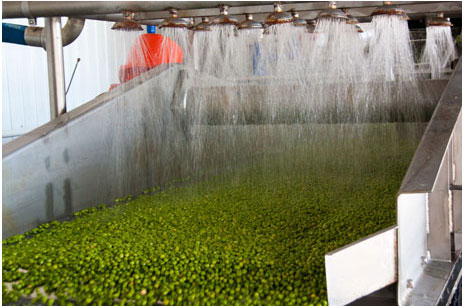
The 2-year project resulted in:
- 6 completed site assessments
- 4 intern projects
- 6 public presentations
- 43 recommendations
- 6,700 clients exposed to P2, E2, and water conservation improvement opportunities in the food processing industry.
When it came to water conservation opportunities, significant savings were discovered by diving deeper into water usage practices and habits in order to determine root causes. For example, at one of the facilities, it was discovered that there was a lack of communication between plant staff as to which team was responsible for shutting off water at the end of a production shift. Designating a team member to take charge over this role and/or placing controls on equipment helped facilities avoid excess water usage.
Furthermore, another opportunity was optimizing flow rates. An important tip to note is realizing that not all processes require the maximum flow that a valve provides. Mechanical stoppers are one way to standardize a set point for optimal flowrate, which can lead to water conservation. An example of this was demonstrated at another facility, where plant workers were discouraged from shutting off water supply to a pasteurizer during down times due to overheating concerns. When analyzing this system, the project team discovered that a broken valve was failing to direct cooling water back to the pasteurizer during restarts. With some minimal repair, the team was able to fix the system, allowing cooling water re-circulation and water conservation. These examples illustrated how different facilities were able to significantly benefit from free site assessments and technical assistance. Low or no-cost solutions to a wide range of opportunities led to valuable efficiency improvements.
Overall recommendations found ways to save or reduce:
- $1.6 million
- 20,100,000 lbs of wastewater loading effluent
- 4,500 metric tons of CO2 equivalent emissions
- 250,000,000 gallons of water
Over $200,000 in savings at 8 different facilities have already been realized through implementation, and many remaining opportunities are planned to be implemented in the future. This project also clearly demonstrated the value in committed time and resources, which increased the likelihood of pollution prevention outcomes. Additional on-site work through site assessments and intern projects facilitated longer interactions, strengthened business relationships, and encouraged companies to follow through with implementation of suggestions. MnTAP thanks the MPCA and EPA Region 5 for their support and partnership in this work and looks forward to further collaboration in the future.
Cold Hard Savings for TRUs
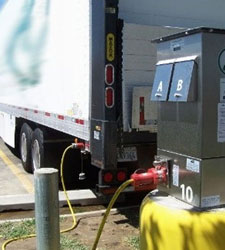 Transport refrigeration units, a.k.a. TRUs, are well used in the food processing industry to keep food at just the right temperature during transport. Conventional TRUs are powered with diesel fuel, but newer models have the ability to run on electricity while stationed at a shore power enabled dock. This electric operation is more efficient than diesel operation, could save money and reduce local diesel air emissions.
Transport refrigeration units, a.k.a. TRUs, are well used in the food processing industry to keep food at just the right temperature during transport. Conventional TRUs are powered with diesel fuel, but newer models have the ability to run on electricity while stationed at a shore power enabled dock. This electric operation is more efficient than diesel operation, could save money and reduce local diesel air emissions.
MnTAP is conducting a study to help quantify the cost effectiveness of switching over to electrified TRUs and shore power dock units. We are looking to partner with three Minnesota companies to participate in no cost assessments to measure cost saving opportunity and air emission reductions from adopting electrified TRUs and shore power.
If you’re interested, please contact Gabrielle Martin at 612-624-0206 or gamartin@umn.edu.
The electrified TRU project is supported with funding from U.S. EPA Region 5
A Blast from the Past: 35 Years of Pollution Prevention Technical Assistance
Compressed Air Systems
Compressed air systems can account for up to 25% of electrical energy use. There are a number of common energy conservation opportunities for any compressed air system.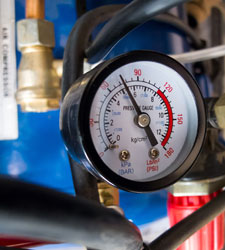
These opportunities include:
- Leak identification and repair
- Pressure reduction
- Control multi-compressor system operation
- Reduce or eliminate inappropriate uses
- Reduce or eliminate humidity performance problems
- Increase receiver storage capacity
- Waste heat utilization
More costly solutions include sequencing and flow controls, variable speed compressors to handle variable loads, and proper sizing and distribution of the compressed air system. Depending on system complexity, compressor system energy efficiency can be improved by as much as 20-50%.
Did you know…
It takes 8hp of fuel to generate the electricity for 1hp of compressed air? A compressed air system can represent up to 20% of your total electrical usage and a savings of 25% can result by taking advantage of some of these simple conservation opportunities:
- Reduce System Demand – identify alternative methods like using a blower or vacuum. Use the Pneumatic to Electric Tool calculator to find savings by switching to electric tools. Disconnect the compressed air source from unused equipment.
- Minimize Leaks – Can you hear it? Compressed-air system leaks can be costly; each 1/8” diameter hole in a 100 psi system can cost you more than $1,200 per year. Consider leak maintenance using an ultrasonic leak detector to find and identify leaks and scheduled repair time.
- Improve Controls – Variable Frequency Drives (VFD) can provide up to 35% energy savings for continual operation at the desired pressure, and pressure control valves or flow controllers can help provide efficient delivery of the air from source to point of use.
- Optimize System Pressure Setpoint – Reducing system pressure by 2 psi can save 1.5% on your operating costs. Make sure the air pressure at your equipment is only what you need.
- Installing High Efficiency Air Nozzles – These nozzles can reduce demand by 50% by projecting a more precise air jet of air for blow-off applications, and also reduce perceived noise levels
- Take advantage of rebates – Rebates are offered by Excel energy that include compressed air audits. Other energy providers offer similar opportunities.
- Check the MnTAP website for more compressed air tips.
- Check out the Compressed Air Challange – for even more great ideas and case studies!
